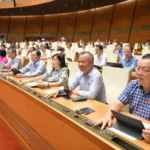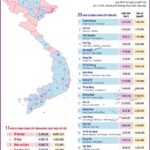
Source: CafeF
On June 12, the National Assembly continued its 9th session of the XV term, discussing in the hall the rearrangement of administrative units at the provincial level in 2025.
According to the Government Portal, in the discussion, most of the deputies expressed their consensus and strong support for the Proposal and Project on the rearrangement of administrative units at the provincial level in 2025. The work has been carefully and thoroughly prepared, with solid theoretical and practical foundations, reflecting the determination to renew thinking, streamline the apparatus, and create development space for localities and the nation in the new period.
The deputies agreed with the proposal, the verification report, the report on the absorption, and the draft resolution submitted by the Government. This is the result of a well-prepared, methodical, and scientific process, with close coordination between the Standing Committee of the National Assembly, the committees of the National Assembly, the Government, ministries, branches, and local governments.
The rearrangement plans are based on legal standards for natural area and population scale, ensuring regional connectivity, management efficiency, and long-term stability.
The process of collecting opinions from voters and local People’s Councils was also carried out seriously and received a very high consensus, reflecting the people’s strong support and expectations for this policy.
Deputy Nguyen Huu Thong of the Binh Thuan Provincial Delegation shared that the past 50 years have shown that the process of dividing administrative units has contributed to security, political, and territorial management goals in each historical period.
However, up to now, this organizational model has revealed many shortcomings. Specifically, many provinces have a small scale, low population, and do not meet the area standards, leading to fragmented development space, difficulty in forming key economic regions, scattered public investment, and low efficiency. The administrative apparatus in many places is still cumbersome, with regular expenditures accounting for up to 70% of the total budget, limiting investment resources for development.
Therefore, the policy of rearranging the provinces and centrally-run cities is a major decision, both strategic and inevitable, to improve the effectiveness of governance and management, reorganize the development space in an expansive, connected, and sustainable direction, promote advantages according to scale, and optimize resources.
This is an opportunity to comprehensively restructure the regional development model, redistribute population, infrastructure, and investment resources according to new strategic orientations. This will contribute to the successful achievement of rapid and sustainable development goals in the new era of the locality as well as the country.
Sharing the same view, Deputy Tran Hoang Ngan of Ho Chi Minh City delegation suggested that, in the context of implementing digital government, digital citizens, and digital society, streamlining the apparatus and merging provinces will help streamline the apparatus and reduce state budget. Especially, the merger of provinces is not just an addition of area and population but also a multiplication of GDP.
The merged provinces will have a larger scale, more diverse natural conditions and resources, and be able to build large-scale socio-economic development plans, attract stronger investment, and organize production and services in a more reasonable and sustainable manner.
The rearrangement of administrative units will facilitate the restructuring of the administrative apparatus at all levels, improve governance efficiency, and enhance the quality of services for people and businesses. This is also an opportunity to promote institutional reform and complete the model of a local government that is streamlined, modern, transparent, and professional.
The Art of Persuasion: Captivating Copywriting for the Win
“Congress Confirms Excise Tax on Air Conditioners and Sugary Drinks: A Refreshing Take on an Old Classic”
Air conditioners with a capacity of over 24,000 BTU to 90,000 BTU, sugary drinks, and gasoline are subject to special consumption tax.
“Creating a Robust and Innovative Mechanism for the Development of Haiphong City”
“Today, the National Assembly continued its 9th session, with discussions on a draft resolution on piloting several specific mechanisms and policies for the development of Hai Phong city. The debate was chaired by Vice Chairman of the National Assembly, Nguyen Duc Hai. This resolution aims to establish unique policies that will accelerate the growth and advancement of Hai Phong, a key urban center in Vietnam.”
The Ultimate Guide to the 34 Provincial Administrative Units: Unlocking Effective Governance
As of June 12, 2025, there are 34 administrative units at the provincial level across the country, consisting of 28 provinces and 6 cities. Of these, 19 provinces and 4 cities were formed after the reorganization, while 11 provinces and cities remained unchanged.





















